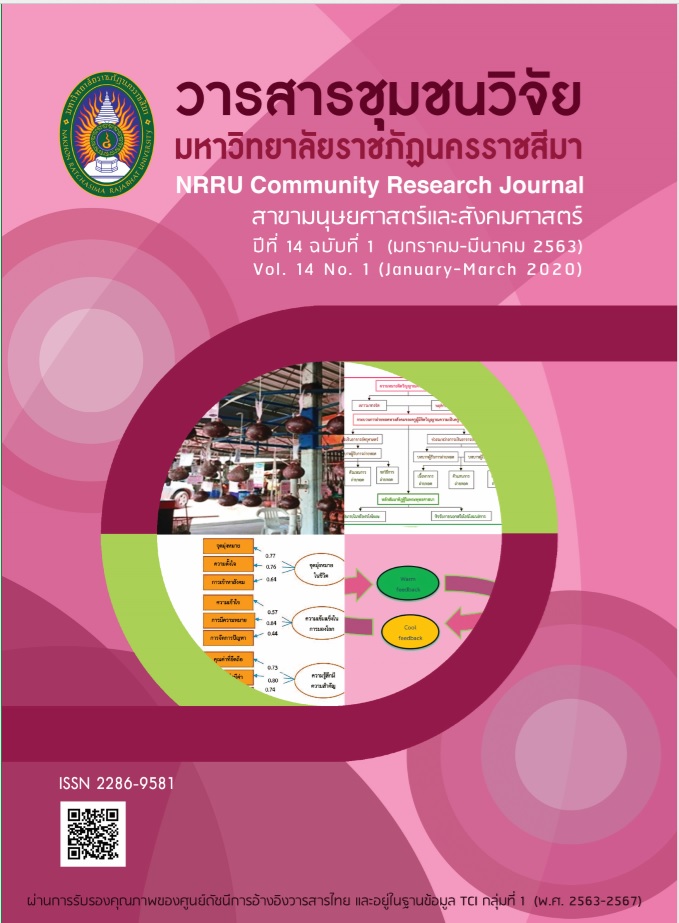ยุทธศาสตร์การสร้างความภักดีให้กับสมาชิกหอการค้าภาคตะวันออกเฉียงเหนือ
DOI:
https://doi.org/10.14456/nrru-rdi.2020.14คำสำคัญ:
การมุ่งเน้นการตลาด, บรรทัดฐานความสัมพันธ์, ประสิทธิภาพการบริการ, ความภักดีบทคัดย่อ
การศึกษาวิจัยมีวัตถุประสงค์เพื่อศึกษาระดับของกลยุทธ์การมุ่งเน้นการตลาด ประสิทธิภาพการบริการ บรรทัดฐานความสัมพันธ์ และความภักดีในการบริการ ตรวจสอบความสอดคล้องของแบบจำลองปัจจัยเชิงสาเหตุ ศึกษาความสัมพันธ์เชิงสาเหตุที่มีต่อความภักดีในการบริการของสมาชิกหอการค้าภาคตะวันออกเฉียงเหนือ ใช้วิธีการวิจัยเชิงปริมาณ โดยใช้แบบสอบถามเก็บข้อมูลกับกลุ่มตัวอย่างเป็นสมาชิกหอการค้าภาคตะวันออกเฉียงเหนือ 331 ราย ทำการสุ่มกลุ่มตัวอย่างโดยใช้หลักความน่าจะเป็นในการสุ่มตัวอย่างแบบหลายขั้นตอน ได้แก่ ขั้นตอนที่ 1 จำแนกหอการค้าภาคตะวันออกเฉียงเหนือออกเป็น 20 จังหวัด และขั้นตอนที่ 2 ใช้การสุ่มกลุ่มตัวอย่างอย่างง่ายกับสมาชิกหอการค้าภาคตะวันออกเฉียงเหนือทั้ง 20 แห่ง ตามสัดส่วนของแต่ละจังหวัด โดยจะสามารถเป็นกลุ่มตัวอย่างได้ทุกคน ผลการคำนวณค่าดัชนีความสอดคล้องตามวัตถุประสงค์ของเนื้อหาเท่ากับ 0.814 และผลการทดสอบความน่าเชื่อถือของเครื่องมือเท่ากับ 0.984 วิเคราะห์ข้อมูลด้วยสถิติเชิงพรรณนา และในการทดสอบสมมติฐาน โดยการวิเคราะห์แบบจำลองสมการโครงสร้าง
ผลการวิจัย พบว่า ตัวแปร และองค์ประกอบทุกด้านมีค่าเฉลี่ยอยู่ในระดับมาก ความสัมพันธ์เชิงสาเหตุมีความสอดคล้องกลมกลืนกับข้อมูลเชิงประจักษ์ในเกณฑ์ดีถึงดีมาก ผลการทดสอบสมมติฐาน พบว่า กลยุทธ์การมุ่งเน้นการตลาดมีอิทธิพลทางอ้อมต่อความภักดีในการบริการผ่านตัวแปรประสิทธิภาพการบริการ และตัวแปรบรรทัดฐานความสัมพันธ์มีอิทธิพลทางตรงต่อความภักดีในการบริการ
เอกสารอ้างอิง
Abdul-Rahman, M. (2014). The Influence of Relationship Quality Customer Loyalty: Evidence from The Practices of Outsourcing in The Malaysian Hotel Industry. Thesis, Doctor of Philosophy degree in Faculty of Businness and Accountancy, University of Malaya, Kuala Lumpur.
Ajzen I. (1991). The theory of planned behavior. Organizational Behavior and Human Decision Processes, (December, 1991), 50(2), 179–211.
Akbari, P., Piri, A., & Charkhandaz, A. (2013). The Study Relationship between Perceptual Market Orientation in Customers and Their Loyalty in Banking Industry of Iran (Case Study: MELLAT Bank of West Country). International Journal of Management and Humanity Sciences, 2(1), 9-20.
Al-Ababneh, M. M. (2016). Employees’ perspectives of service quality in hotels. Research in Hospitality Management, 6(2), 189-194.
Bloemer, J., Ruyter, K. D., & Wetzels, M. (1999). Linking perceived service quality and service loyalty : A multi-dimensional perspective. European Journal of Marketing, 33(11/12), 1082-1106.
Casidy, R. (2014). The role of perceived market orientation in the higher education sector. Australasian Marketing Journal, 22(2014), 155–163.
Cronin, J. J., & Taylor, S. A. (1992). Measuring service quality: A Re-examination and extension. Journal of Marketing, 56(7), 55–68.
Hair, J. F., Black, W. C., Babin, B. J., & Anderson, R. E. (2014). Multivariate data analysis (7th ed.). Harlow : Pearson Education Limited.
Heidarzadeh, K. H, Nayebzadeh, S., & Jalaly, M. (2012). The Effect of Market Orientation, Innovation and Customer Loyalty on Firm's Performance (Case Study: Islamic Clothing Manufacturing Company). J. Basic. Appl. Sci. Res., 2(4), 3225-3234.
Heide, J. B., & John, G. (1992). Do Norms Matter in Marketing Relationship?. Journal of Marketing, 56(April 1992), 32-44.
Ishak, K. A. (2016). The Impacts of Relational Norms and Relationship Quality in to Franchisee’s Loyalty. International Review of Management and Marketing, 6(S4), 6-11.
Ivens, B. S., & Pardo, C. (2007). The Impact of Governance Mechanisms on Relationship Quality: Effects in Key Account and Non Key Account Dyads. Industrial Marketing Management, 36(4), 470-482.
Leong, L. Y., Hew, T. S., Lee, V. H., & Ooi, K. B. (2015). An SEM–artificial-neural-network analysis of the relationships between SERVPERF, customer satisfaction and loyalty among low-cost and full-service airline. Expert Systems with Applications, 42(2015), 6620-6634.
Maryam, S., Marzieh, T., & Marzieh, G. (2014). Relationship among market orientation, service quality and organizational performance from perspective of Gonbad Kavoos Telecommunication firm employees. Advances in Applied Science Research, 5(3), 464-466.
Murali, S., Pugazhendhi, S., & Muralidharan, C. (2016). Modelling and Investigating the relationship of after sales service quality with customer satisfaction, retention and loyalty–A case study of home appliances business. Journal of Retailing and Consumer Services, 30(2016), 67-83.
Narver, J. C., & Slater, S. F. (1990). The Effect of a Market Orientation on Business Profitability. Journal of Marketing, 20-35.
Orel, F. D., & Kara, A. (2014). Supermarket self-checkout service quality, customer satisfaction and loyalty: Empirical evidence from an emerging market. Journal of Retailing and Consumer Services, 21(2), 118-129.
Parasuraman, A., Zeithaml, V. A., & Berry, L. L. (1988). SERVQUAL: A Multiple-Item Scale For Measuring Consumer Perceptions of Service Quality. Journal of Retailing, 64(1), 12-40.
Pearson, R. H., & Mundform, D. J. (2010) "Recommended Sample Size for Conducting Exploratory Factor Analysis on Dichotomous Data," Journal of Modern Applied Statistical Methods, 9,(2), 359-368.
Ramayah, T., Samat, N., & Lo, M. (2011). Market orientation, service quality and organizational performance in service organizations in Malaysia. Asia-Pacific Journal of Business Administration, 3(1), 8-27.
Rovinelli, R. J., & Hambleton, R. K. (1977). On the use of content specialists in the assessment of criterion-referenced test item validity. Dutch Journal of Educational Research, 2, 49-60.
Srisatidnarakul, B. (2010). Research Methodology: Guidelines for success. Bangkok : U&I Intermedia. (In Thai)
Thai Chamber of Commerce. (2017). About us: Retrieved July 1, 2017, from https://www. thaichamber.org/th/about. (In Thai)
The Office of Small and Medium Enterprises Promotion. (2017). The Fourth SME Promotional Master Plan (2017–2021). Retrieved July 1, 2017, from https://www.sme.go.th/en/ (In Thai)
Valta, K. S. (2013). Do relational norms matter in consumer-brand relationships?. Journal of Business Research, 66(2013), 98-104.
Wu, P. W., Chan, T. S., & Lau, H. H. (2008). Does consumers’ personal reciprocity affect future purchase intentions?. Journal of Marketing Management, 24(3), 345-360.





